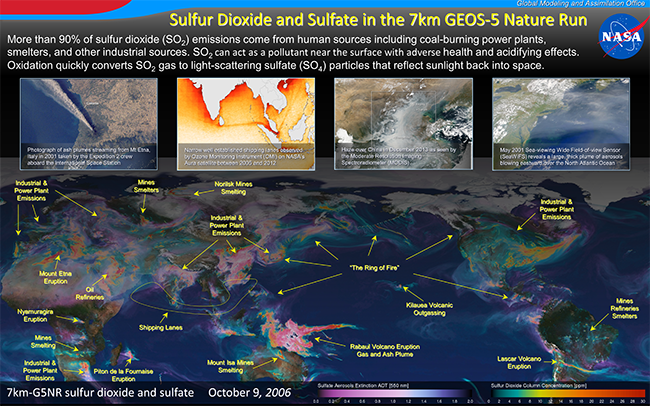Sulfur Dioxide and Sulfate in the 7km GEOS-5 Nature Run
Sulfur dioxide (SO2) is one of a group of highly reactive gasses known as "oxides of sulfur" that can act as a pollutant near the surface leading to poor air quality around major emission sites. The largest sources of SO2 emissions are from fossil fuel combustion at power plants (73%) and other industrial facilities (20%). Smaller sources of SO2 emissions include industrial processes such as extracting metal from ore (smelting), and the burning of high sulfur containing fuels by locomotives and large ships, and natural sources including volcanoes. High concentrations of SO2 at the surface can cause haze and is linked with a number of adverse effects on the human respiratory system. With a mean lifetime of just a couple of days in the troposphere, emitted SO2 is quickly converted to sulfate aerosol (SO4) through oxidation by OH or by reaction with H2O2 within clouds. The resulting SO4 exerts a direct radiative effect on the atmosphere by reflecting sunlight back into space and it can also have an indirect effect by inducing changes in cloud and precipitation microphysics.
In the United States (US), the passage of the Clean Air Act in the 1970s has lead to a dramatic reduction in SO2 pollution. Environmental Protection Agency (EPA) enacted standards and the installation of scrubbers on coal-fired power plants has reduced the concentrations of SO2 in the US by nearly 80% since 1980. Advanced sensors including the Ozone Monitoring Instrument (OMI) flying on NASA's Aura spacecraft since 2004 have been employed to measure SO2 from space, while the Cloud-Aerosol Lidar and Infrared Pathfinder Satellite Observation (CALIPSO) satellite launched in 2006 provides observations of atmospheric sulfate aerosols.
The 7-km GEOS-5 Nature Run (G5NR) includes these important constituents and produces a realistic distribution of their concentrations around the globe. SO2 can be seen streaming from industrial emissions throughout North America, Europe and Asia. Mining locations where metals are extracted from ore during smelting have a number of emission locations with major smelting sites over Russia, Africa, South America and Australia. Shipping lanes through the Indian Ocean and West Pacific can also be observed from SO2 emissions in the 7-km G5NR. Natural sources of SO2 from volcanic emissions can be seen throughout the "Ring of Fire" surrounding the Pacific Ocean, and from other significant eruptions including Mt Etna in Italy and the Rabaul Volcano in New Britain. Patterns of high SO4 fraction are associated with these anthropogenic and volcanic sources of SO2. While the highest concentrations of these pollutants can be seen surrounding primary emission sites, SO2 and SO4 can be exported over long distances within the prevailing winds of the global circulation of the atmosphere.


